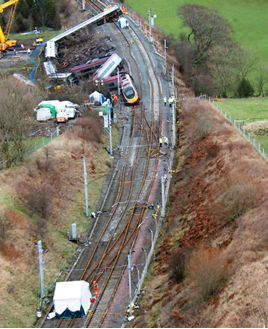There was nothing particularly special about the points. They had been built to a standard design in widespread use since the early 1970s. Their non-adjustable stretcher bars had been around even longer - over 50 years. The RAIB concluded that the design of the joint between the permanent way stretcher bar bracket and the switch rail at those, or any other similar points, was such that it could have been subjected to forces beyond its design capability.
This put a greater importance on regular inspection and maintenance if they were to be kept in a safe operating condition. The trouble was that Network Rail did not understand the fact that pointwork with non-adjustable stretcher bars behaved differently from other designs. Indeed, “the relationships between its design, usage, loadings, inspection and maintenance”, led the company “to consider that the risk associated with the design was low and [...] adequately controlled”. This also resulted in “an absence of clear and properly-briefed standards” for setting up and adjusting such points.
The performance of the train itself wasn’t brought into question. The RAIB agreed with Branson that the Pendolino “avoided, almost completely, a number of hazards”, noting in particular the robustness of the couplers (which generally held the carriages together), the anti-roll bar links (which ensured that most of the bogies remained attached), the penetration resistance of the bodyshell, and its impressive roll-over strength.
The RAIB also praised the train’s laminated windows, which largely kept passengers contained safely within, although two were injured after they’d been partially or wholly ejected through breakable emergency exit panes; the standard at the time permitted at least one non-laminated window per carriage, for egress. Some passengers in the leading vehicle had also been struck by reading light panels that had become detached.
The report included 29 recommendations. Some of these sought clarity on certain aspects of the train’s behaviour, but most involved the risks associated with maintaining points and crossings. Network Rail brought in better instructions, management and checks on basic visual inspections, surveyed the amount of residual switch opening on what it perceived to be the higher-risk points on its system, launched a rectification programme and started to analyse the loads and forces in its non-adjustable stretcher bar assemblies.
On January 13 2012, the Office of Rail Regulation (ORR) announced that the company would be prosecuted under Section 3(1) of the Health and Safety at Work Act 1974 for its “failure to provide and implement suitable and sufficient standards, procedures, guidance, training, tools and resources for the inspection and maintenance of fixed stretcher bar points”. It was later fined £4,118,037
The points which caused the derailment were removed and replaced with continuously-welded rails for 2.2 miles through the Grayrigg area.
A major train accident sticks in the national conscience, and its location alone - be it Quntinshill, Lewisham, Polmont or Potters Bar - is often enough to stir the memory and chill the blood. When the tenth anniversary of the Ladbroke Grove SPAD and collision drew near, I helped to write a Rail Safety & Standards Board (RSSB) report on the improvements in train accident safety the railway had made since that dark day. It’s still on our website, and in it we talked of the “extensive changes, including institutional reorganisation, significant growth and further investment” that had taken place during that decade.
The learning and improvements the industry accumulated since Ladbroke Grove meant that rail became ever safer. While 51 passengers lost their lives in train accidents between 1999 and 2008, fatalities have been decreasing since the early 1950s, when the introduction of BR’s Automatic Warning System (AWS) started to make inroads on the number of signals passed at danger. The situation improved still further following the widespread introduction of the more interventionist Train Protection and Warning System (TPWS) in 2003.
Among the improvements more relevant to Grayrigg, the report chimed with RAIB’s, and noted how RSSB’s research programme had contributed to the conclusion that the (then) current bogie attachment strength requirements were adequate. It added that City of Glasgow - which had been built to that standard - experienced “very limited bogie detachment compared to earlier accidents”, during which “significant numbers of bogies” had come off, torn into carriages and harmed those on board.
The same was true of the containment question. Analysis had shown that of the 51 fatalities, 20% had occurred through people being ejected through windows (usually when a carriage had turned onto its side). The report also made the important point that “the rail industry’s primary safety objective is to avoid accidents in the first place”, and while admitting that there will always be ”some residual risk associated with the transportation of people and goods”, it also referred to the vital role played by the learning that flows from operational experience, near misses and accidents.
Of course, this is something the industry - or whichever regulatory body oversees it - has been doing virtually since its inception. Early incidents such as the death of William Huskisson MP at the opening of the Liverpool & Manchester Railway in 1830, for example, led to the first Railway Regulation Act (1840), which required all injurious accidents to be reported to the Board of Trade.
Within 50 years, block signalling, interlocking and continuous braking on passenger trains had been made mandatory. There were further advances in the 20th century, ranging from continuous welded rails and multi-aspect signalling, through to the aforementioned AWS and TPWS (to say nothing of those all-important strides in crashworthiness). All of these have contributed to the ever-decreasing number of train accident fatalities, and the fact that only one person was killed at Grayrigg.















Login to comment
Comments
No comments have been made yet.